
Original Link: https://www.anandtech.com/show/2626
The Radeon HD 4870 1GB: The Card to Get
by Derek Wilson on September 25, 2008 12:00 AM EST- Posted in
- GPUs
With the launch of the Radeon HD 4870, AMD showed us that they are not only still in the game, but they are back. Their hardware either out performed or was on par with NVIDIA hardware priced significantly higher. As a result, NVIDIA was forced to significantly adjust their prices downward to remain competitive. And, currently, they are competitive in terms of pricing and performance.
But in this business competitive isn't always good enough. AMD came out of the gate swinging for a knock out. And they did a good job of winning a significant amount of mindshare. They built a good product and priced it very aggressively at launch. While our concern is the current state of things, and our recommendation will be for the part that gives our reader the best value, that's not how every graphics card enthusiast sees it. The things companies do (like initially selling their hardware at way too high a price) can significantly affect the position of some enthusiasts.
That might be one reason NVIDIA went down the core 216 path with the GTX 260. A name more like GTX 265 would have been nice, and we already talked about how much we don't need dozens of parts all with slight tweaks and price differences cluttering up the market. But, the core 216 did help make NVIDIA's hardware more competitive (even if it didn't put it over the top). And more competitive is a good thing. Better competition does nothing but benefit the consumer, and we love to see it. If NVIDIA took that step because they want to win back some mindshare then that's fine with us. All we care about is what performs best in a price class, because that is what benefits our readers.
Of course, the core 216 might also have been anticipating the eventual availability of the Radeon 4870 1GB. In which case, the core 216 falls short.
Well, it isn't just that the GTX 260 falls a little short. The fact is that the extra RAM really does make a significant difference in many high quality high resolution situations when playing current games. We didn't expect the gains we see here, and combined with the original stellar performance of the Radeon HD 4870, we have to say that we are impressed.
The Radeon HD 4870 1GB has the same number of GDDR5 chips on board, but the devices on the 1GB model are double the density of the 512MB part.
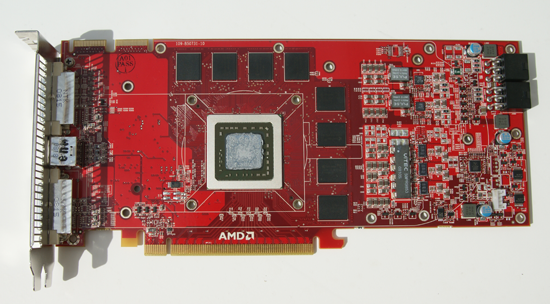
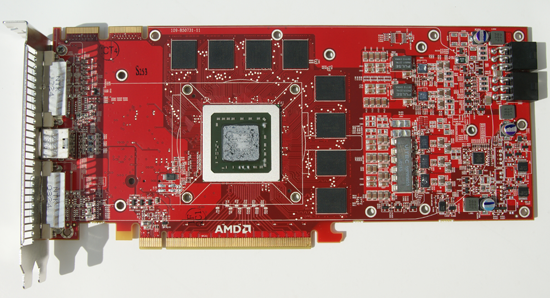
Yes, these are different parts. The top one is the 512MB version and the bottom one is the 1GB.
The 512MB card we have uses Qimonda GDDR5, while the 1GB model we tested has Hynix devices. As GDDR5 is still pretty new, it is likely that the delay in getting out the 1GB model of the 4870 had to do with delays in getting a high enough supply of high density RAM.
Anyway, we mentioned that the GTX 260 core 216 doesn't quite keep up now that the 4870 has twice as much RAM. Let's take a look ath exactly how short it falls, first in terms of how much performance we gain over the original model and then in absolute terms.
The Test and Performance Improvement
Here's our test setup:
| Test Setup | |
| CPU | Intel Core 2 Extreme QX9770 @ 3.20GHz |
| Motherboard | EVGA nForce 790i SLI |
| Video Cards | ATI Radeon HD 4870 X2 ATI Radeon HD 4870 ATI Radeon HD 4870 1GB NVIDIA GeForce GTX 280 NVIDIA GeForce GTX 260 SLI NVIDIA GeForce GTX 260 NVIDIA GeForce GTX 260 Core 216 |
| Video Drivers | Catalyst 8.7 ForceWare 177.34 |
| Hard Drive | Seagate 7200.9 120GB 8MB 7200RPM |
| RAM | 4 x 1GB Corsair DDR3-1333 7-7-7-20 |
| Operating System | Windows Vista Ultimate 64-bit SP1 |
| PSU | PC Power & Cooling Turbo Cool 1200W |
Performance Improvement
So we'll spoil it right up front and give away the answer to the question on everyone's mind: how does performance improve with the addition of the extra 512MB of RAM to the 4870? And since we got a nice little surprise last week with the GTX 260 Core 216, we can even compare performance improvement of the slightly upgraded models of both the NVIDIA and AMD parts.
These comparisons are taken from the highest playable resolution in each game we tested, which is either 1920x1200 or 2560x1600 depending on the game. This class of card is able to handle the highest resolutions, but sometimes not with all the features cranked up (as our tests are designed). These high resolutions do the best job at stressing both memory and processing power, as processing more pixels every frame has an impact on both.
Another factor to consider is that we can't really tell you the maximum potential theoretical performance gain from adding more memory to a system. With the NVIDIA GTX 260 core 216, we know the maximum theoretical improvement is something like 12.5 percent. This is because we added 12.5 more compute resources. But doubling the amount of RAM, we aren't really doing anything directly to performance: we're just increasing the availability to resources to the hardware which may or may not improve utilization. Adding more RAM decreases the chance that something will need to be pulled in from system memory.
Both routes have the potential to improve performance, but both also speak to the balance of the initial design. We really don't want more memory on a board than we need to adequately feed the GPU, and, at the same time, we don't want so many compute/texture resources on the GPU that we can't possibly feed it enough data to crunch. From our perspective, it looks like the Radeon 4870 with 512MB was targeted at 1920x1200 or lower resolutions. More RAM has a lessened impact on lower resolutions, and the price point of the 4870 is generally in line with what a gamer would love to have paired with a high end 1920x1200 panel. People that buy 30" panels for gaming are more likely to go after more expensive solutions.
Some games also show a benefit from more RAM regardless of resolution, meaning they are very resource intensive games. While you can't make purchasing decisions based on future-proofing (there's really no way to accurately predict what card will do better in the future), the trend has generally been that newer games use larger and more textures and pile on more effects which take up more space in local memory. While the games that benefit across the board now are few, it is possible we could see that number increase down the line.
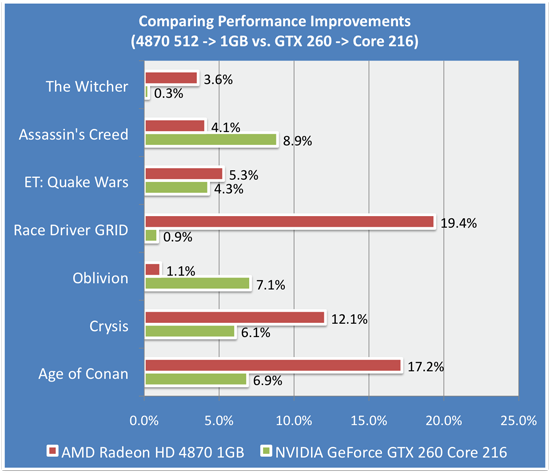
Oblivion and Assassin's Creed are the only two tests we see that don't see better improvement on AMD hardware. Perhaps not-so-coincidently, Oblivion is also one of two tests we ran where the NVIDIA GeForce GTX 260 Core 216 leads the AMD Radeon HD 4870 1GB (and the only test we ran where the original GTX 260 leads the 4870 1GB) - the other being The Witcher. This does change things up again, but it also highlights that the GTX 260 and 4870 are fairly well matched in general. With minor tweaks to performance they we are seeing a back and forth on whose part leads in our benchmark suite. It's like we have NVIDIA and AMD playing that game where each one grabs slightly higher on a stick.
Unlike the core 216, we've known this 1GB 4870 was coming down the pipe for a long time, and we've honestly expected some performance gain at high resolution. But we really didn't expect this much of a difference. The differentiation between the products is better with 4870 1GB than on NVIDIA hardware.
Let's drill down and look at individual game performance to get the rest of the picture.
Age of Conan Performance
This is one of a couple games where we saw the Radeon HD 4870 perform very strongly in the first place. The additional RAM actually boosts performance to more than that of the GTX 280. In fact, the 1GB 4870 is a little more than 14% faster than the GTX 280 at 2560x1600. For the way I play MMOs, 25 frames per second is just at playable, and running at native resolution is worth the trade off in framerate. But that's a very subjective thing, and others may prefer to drop back to 1920x1200 on this title.
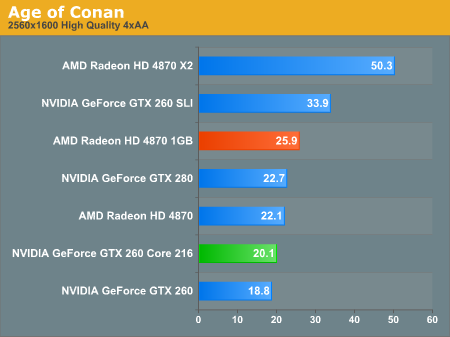
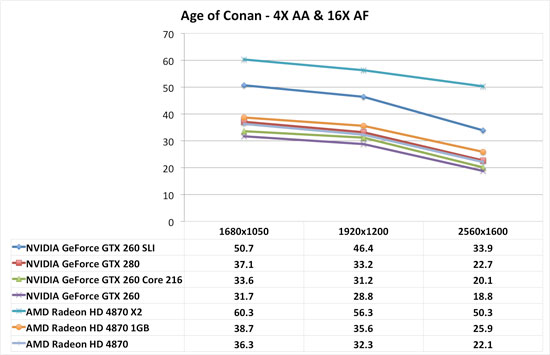
Crysis Performance
Ahh, Crysis. The ever contended benchmark. At the highest playable resolution with the settings we tested (1920x1200), the Radeon HD 4870 1GB leads the GTX 260 core 216 by about 5.7%. Interestingly, the GTX 280 only has a 7.5% lead over the 4870 1GB. The extra memory really seems to have made a difference here, and we aren't even looking at 2560x1600.

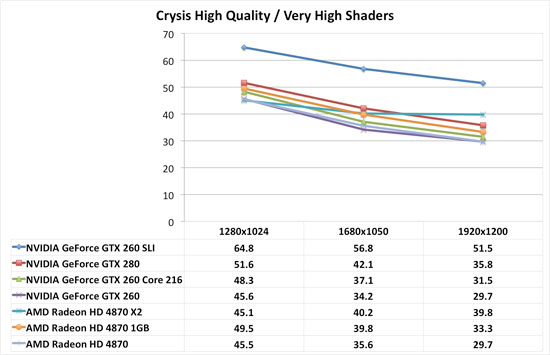
The Elder Scrolls IV: Oblivion Performance
This game is a bit older and so it doesn't push the memory envelope quite like some of these other titles. As such, it really doesn't benefit that much from the additional RAM. Combined with the fact that NVIDIA hardware seems to handle Oblivion better, and this is one of only two games we tested where the Radeon 4870 1GB doesn't lead at its price point (or beyond).
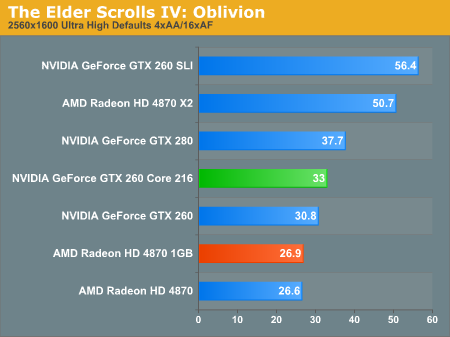
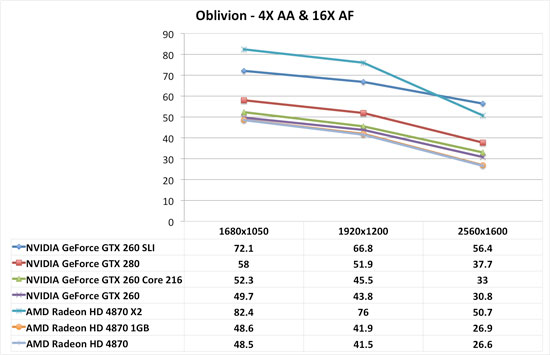
Enemy Territory: Quake Wars Performance
Coming in at just under 5% faster than the GTX 260 core 216, the Radeon HD 4870 1GB pulls out the win again. While this isn't a huge competitive advantage, it is an advantage nonetheless (we generally call a difference of 3% or less a wash unless the benchmark isn't as repeatable as we would normally like). At lower resolutions, the advantage was already there with the 512MB 4870.
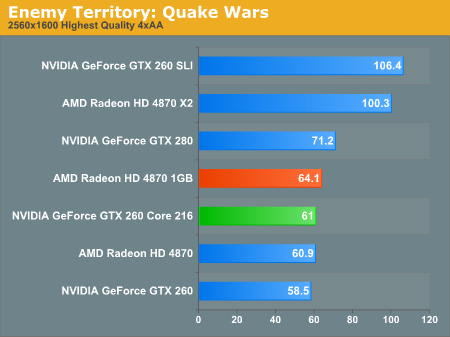
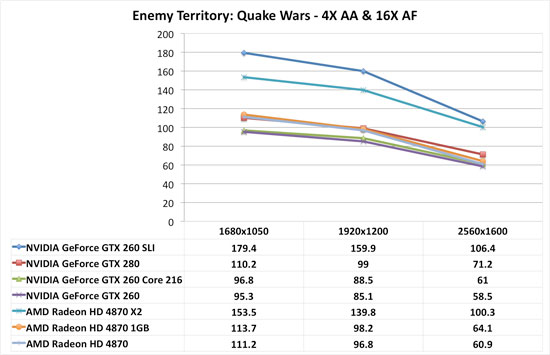
Race Driver GRID Performance
The 512MB 4870 already leads the GTX 280 in this test, but the additional RAM made a huge difference for the 1GB version as well. This culminates in a little more than a 29% performance advantage for the Radeon HD 4870 1GB over the GeForce GTX 280 at the highest resolution we tested. This is simply huge and shows the differing potential of AMD's design to really rock the boat. Plus GRID looks really good at any resolution, but it is simply stunning at 2560x1600 with 4xAA.
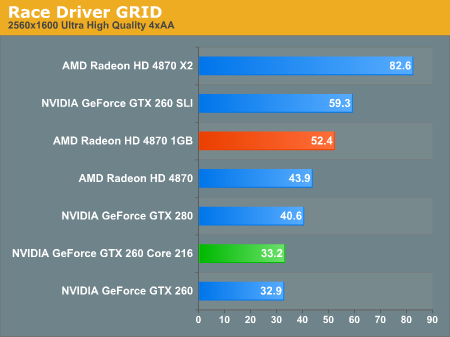

Assassin's Creed and The Witcher
And just to round out the numbers, we've got one more test where the 4870 1GB leads the GTX 280 in performance (Assassin's Creed) and another where AMD's new card doesn't have quite enough to push past NVIDIA's GTX 260 core 216 (The Witcher). Both versions of the 4870 and the GTX 260/Core 216 are all virtually tied in the latter, so it seems The Witcher is more bound by memory bandwidth rather than memory capacity or computation power.
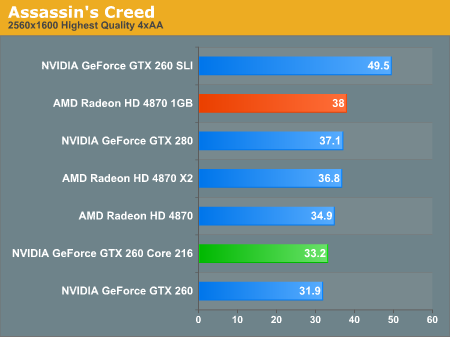
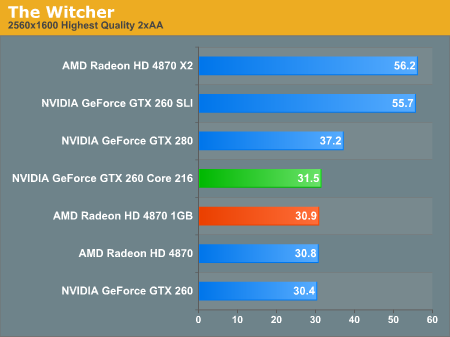
Power
There really isn't much to say about power that hasn't already been said about the 4870. It still draws a significant amount more power at idle and load than the GTX 260. The interesting thing is just how little difference going from 512MB to 1GB of RAM makes in terms of power. The two 4870s come in at just about the same power draw in both idle and load tests.
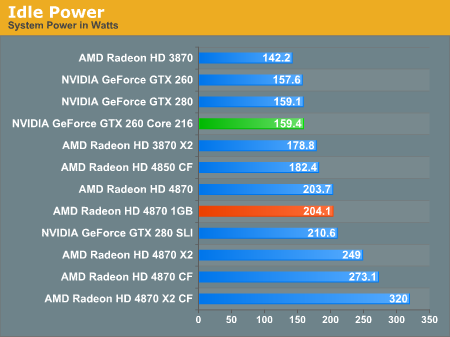
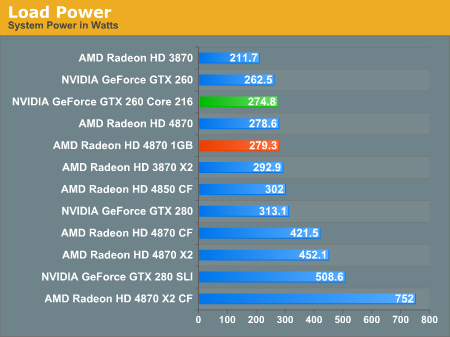
Final Words
The Radeon HD 4870 1GB is a better buy than both the GTX 260 and core 216 variant. AMD says MSRP is between $280 and $300, and a quick look at Google shows us that the Sapphire Radeon HD 4870 1GB is priced at $290. This is definitely not bad for the types of performance gains we are seeing. If the card is to be used for high resolution gaming with all the settings, then up to a 10% to 15% increase in price over the stock 4870 is not a bad investment (unless, of course, you only play the games that don't see a real benefit from the additional RAM). And at these settings, there's an additional bonus in that this performance improvement might just make the playability difference for some people in some of these games.
While the 4870 512MB part can be had for $20 or $30 cheaper than the 4870 1GB (if you shop around), many of the 512MB variants are still priced in the same range as the 1GB cards. There is no reason to buy the 512MB part if prices are equal, so we hope to see a downward shift in price for the 512MB version. We haven't heard any confirmation on this from AMD or their partners, but it really should be a matter of simple economics. It will be harder to move parts priced at $280 to $300 when you can get something that's better for the same amount of money. Thus prices should drop, if not for the minimum then at least for the average price of a 4870 512MB.
We can't say whether or not the 1GB card will have an advantage going forward, as there is a heavy push for making games more compute heavy. Larger textures and the like are always rolling out, but if the future direction leans on compute more we may see the 4870 limited in ways that it can't overcome. Conversely, the GTX 260 core 216 may benefit more or less in the future depending on what developers decide to do. While it'd be great if there were better answers here, it's a guessing game and it's all about balance. What we can say for certain is that the 4870 1GB and core 216 are both at least equal to their older siblings, so at least you'll never lose performance.
For now, it looks like the 1GB of RAM is a better balance for the RV770 GPU on current games, especially when leaning toward higher resolutions. At the prices we are seeing, it's a better balance for the consumer as well. The Radeon 4870 1GB gets our recommendation at the $280 - $300 price range.
And it's not only that. While the 4870 was actually competitive with the GTX 280 in some cases, the additional RAM actually increases that competitive edge. Yes, this is only in a few games, and we can't recommend the 4870 1GB over the GTX 280 in the general case, but there is clearly a value advantage here that can't be overstated. If you don't need the best of the best (or you aren't willing or able to spend the money for it), the 4870 1GB is a very strong solution.
So, what's the bottom line? This is currently the card to get.













